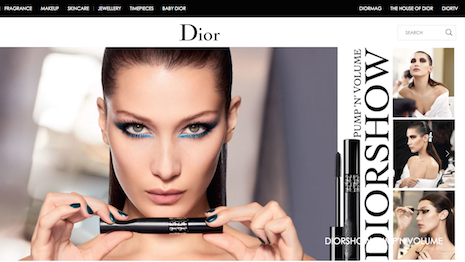By Dennis Callaghan
It is no secret that affluent consumers want a luxury experience to accompany the actual products they seek.
As the sale of luxury goods continues its shift to digital, having a fast Webpage load time – the time it takes for enough page elements to load for an end user to begin interacting with the page – is a critical customer experience mandate. With this in mind, the following is our second-quarter 2017 luxury site performance analysis.
Luxury desktop sites
The five strongest performers on desktop in Q2 were Dior, Porsche, Patek Philippe, Chanel and Audi, in that order. Each had Webpage load times of 2.6 seconds or faster.
In Q2, the average Webpage load time for the 25 desktop sites in our analysis was 3.82 seconds – slower than the 3.57 seconds recorded in Q1.
In our last analysis, we referenced a study by Exane BNP Paribas Researchers, which graded 32 leading luxury sites on the basis of 18 different criteria, spanning the categories of reach, customer experience and engagement.
One key finding in that study was that in spite of an ongoing, obvious distinction between the leaders and the rest, the gap between the two groups seemed to be narrowing.
When we conducted our Q4 2016 to Q1 2017 quarter-over-quarter comparison, our observations aligned with this study – we saw many companies whose average speeds were four seconds or slower in Q4 2016, improved into the three-second range in Q1 2017.
However, in Q2 the opposite seems to be happening, with the most significant trend being companies who had been in the two-second range in Q1, now sliding into the three-second range.
The number of companies delivering Webpage load times of four seconds or more has stayed roughly the same.
One primary reason may be that the average total downloaded bytes – 4.13MB in Q2 –has increased by about 10 percent, along with the average number of third-party hosts, which was slightly higher in Q2.
The average number of downloaded items in Q2 was slightly lower than Q1, though the average image size was roughly the same. Of all types of Web content, heavy images can often have an especially negative effect on site speed.
We recently conducted a separate analysis that found a direct correlation between the sheer number of third-party hosts incorporated into a site and overall site performance.
When measured individually, most hosts deliver speedy response times. It is the combining of many external hosts on a Web page, and the back-and-forth interactions they each require, which can create a slowdown.
While keeping sites as lightweight as possible is a key strategy that organizations can adopt to improve performance, we are finding that the number of third-party hosts per page can have an equal or greater effect, particularly in industries such as retail that rely heavily on external ad and marketing hosts.
In fact, this quarter we saw several instances where heavier sites delivered better performance than lighter sites, due to having fewer hosts.
One example is Prada, which was by far the heaviest desktop home page at nearly 17MB.
However, Prada kept its number of hosts very low, which helps the brand offset, to some degree, the negative-performance effect of the heavy page, delivering stronger speed than several lighter sites.
Audi and Patek Philippe also demonstrated this trend – both were significantly heavier than average, but had relatively low numbers of hosts and items, which helped them deliver above-average speeds.
Conversely, Cartier had a high number of hosts, but a relatively low page weight, which allowed the jeweler to slightly beat the average speed.
The two lowest performing sites had the third-biggest and second-biggest number of hosts and items, but were much closer – both in the 3MB-4MB range – to the average total downloaded bytes than Prada.
Perhaps the most interesting example this quarter was top performer Dior, whose total downloaded bytes may have been slightly lower than average, but whose numbers of hosts and items were quite high.
The secret is in Dior’s page design, which strategically loads content essential to user interaction before non-critical and third-party host content. This minimizes the potential negative effect on user perception.
Luxury mobile sites
The five strongest Q2 performers on mobile were, in this order, Dior, Porsche, Patek Philippe, Audi and Chanel – the same five as in desktop, although Chanel and Audi were reversed in order.
In Q2, the average Webpage load time for the 24 mobile sites in our analysis was 3.7 seconds, a slight degradation from the Q1 average of 3.58 seconds.
In our Q1 analysis, we noted that the trend of companies’ speed metrics clustering closer to the top – when compared to Q4 2016 – was not as apparent in mobile as it was in desktop.
But like desktop, a comparison of Q1 to Q2 reveals a slowing trend, with the majority of movers slowing from the two-second category, down to the three-second category.
Given that two-seconds or less is a well-defined performance expectation in mobile – and we are talking only one added second here – this trend may not yet be cause for alarm, but it is something to watch.
The average total downloaded bytes per page in Q2 was 3.68, representing a 15 percent weight increase over Q1. The average number of hosts per page actually decreased slightly from Q1 to Q2, while the average number of items rose, along with the average image bytes.
Prada’s mobile site, like its desktop, was significantly heavier than the industry average, but the Italian brand mitigated the negative-performance effect by keeping its number of hosts and items low.
 Prada's mobile site homepage. Image credit: Prada
Prada's mobile site homepage. Image credit: Prada
Burberry seems to have deployed an opposite strategy – it has a high number of hosts and items but the brand keeps its page weight extremely light.
As in desktop, Dior was the top performer, due in large part to its being the lightest site on the index, as well as a low host and item count.
Porsche (#2) had a lightweight page and the second lowest number of hosts and the lowest number of items, while Patek Philippe (#3) had a heavier-than-average page, but the lowest number of hosts and the fourth-lowest number of items in the index.
The two bottom performers had the two largest numbers of hosts and items, although as in desktop, their average total downloaded bytes hovered around the average.
WE CONTINUE to see a clear correlation between desktop page weight and speed, but the number of third-party hosts seems to be yielding an increasingly significant effect.
In mobile, heavier pages and, more specifically, the total number of image bytes, seems to be the biggest determinant of site performance.
Perhaps the greatest risk that luxury retailers face – in both the desktop and mobile realms – is trying to incorporate so much feature-rich content and functionality that they ultimately do themselves a disservice from a performance perspective.
The bottom line: sites cannot be both heavy and excessively loaded with third-party hosts and images. Sites that veer to either end of this spectrum must compensate on the other side, and even then, they are likely to require additional steps to avoid performance degradations.
 Dennis Callaghan is director of industry innovation at Catchpoint Systems
Dennis Callaghan is director of industry innovation at Catchpoint Systems
Dennis Callaghan is director of industry innovation at Catchpoint, New York. Reach him at [email protected].
{"ct":"ujfJvfDJGH7xftWJSSTrv6Nrcjo3qnh+joKhODE+93AiIi4nvJWaMiA\/spLw8kSlHy\/QZ5AxFhrKEVD+MpwgfdR1NUdyDFZB1F2qwqCE6MPl0nmHpsfGEFxjH+stwznPxwQKzYWQvzikDCCKABdNjHPnWvi+yG9jjke7xhvHgsYFJX6xTX0vn9j5zTPlGztIooLv79fi9uPd0QeHWXxnVXrrjXt12iQrp\/bZUV4DsFD2ucRw+VYlTB2Aa+XJvDsLNVdsTYAy\/sNk\/qi5XiG88jSlVg0dpTEtV+fr9EB\/luX34oj6AouP8PyCgdGWXzdzYfjoMGF6diKUosjOw7qiAZaPzaDBHe9xiEkW\/sxU2Y8L9lcIirHmsXdvkktufJvQdrPVUT2qf1flYz73ahho\/IcZBulEv1pX4222U2RAgRppAyi6SgCSBlvoEWsy2JWS6snpX62bNVVaNzbD7scNj\/Ic7r7oR7HGiS6gKXqmW5kCA7ZLYlvfCyg8YUrT6MRiWrRgBBloXSwJkfExciR7tCXl91LMIYmynMvkiJo49Pgus67ybwCuoeMp+T8HLusYMoFFAuKsS2dhX7iEIQIEtnerhNVz8i58c8IQTeSOhjX9gV\/Tw3QbG8uhQp12zkzikP\/CxEL+yf3O+Xg2TFqSVZcZefGl+Fg9hVJqpbc\/5RhrLEw8+UsnCjDpf\/I+XuMRZY3YjNG8qmI6yU5XEfqWpI0bvKSm+Xbw9v8vWl\/tdhXd1v\/Cb3sL6G\/kl4isPjXihPh0hpjQ4YamJqGWEeoruhopwUdKs2SIPMDewqbGWIkyBlH5v3ZO0hNgn1a99RhPESP3d7PLzXV9DRwTE5wq9iLg+3V3RsiWlpfZNcAr\/LQYVWumoa1Beg0uvslEFlCfRLdqew5OxGItiT1jdLDJuApknhFJtZranTZr3oQkjaZ21IvsllUbepNokDJ\/C7jteXyEfPVlf3fhxQrpescfRFGYFm0hJlngf4Joqr4XxZkz7pL+VFiO\/eVw3JSuxXYN+7r8lB9tSs5hDDje3vN5nM2pDHYjUI11jQaQLzwfNDAoBeajqZLD7RLXQ71KQvo7feas+mGlqFQbxDVjrmbx2Q02xL5ArKmQT2Q\/9TfR3Facy8uxOI8JMI658BWE8MJ6ShE\/MnRF3psoY9oI0keTJ8YWH9se15wW1ljgf63qFhrA8IKlu1VAbpQsd+sJ+dIEEeTAi9CofU4BIsHYssv6c5KVA8bNmZOBZ+mLMdXlBpnxZotRqDm2\/jejrqwAh\/ggq0u80UB9WkDaPCz33Q42o8rxFSjZNq+npISOh7gQeZU77ZSnFGCsxzmPMXHTSVdOIDFLaH3Y4yvLUPd4rzLO+qaXIjcqraus880x6\/S0v8IDCKW3hTVqRFeZQGmxXvvaO+4EHeKJ+k3J164lPLkVx56FXYqoZDVIn7QDta\/IPKmjc7c5an3qQjI3lX+S0AHSSYXvor1uBZmHCp6U\/PUspFbSvpmIU6GZ8zgbR8vNfQmm8VNrjHP3BcUXXHoRlPHLlnLjoHnsVnEGqyYpOGtUcuCIRUZ+0e2fM11G78F0H0aj6F8Q68AhTJVUCy++cM2ZFXlXvvWk\/OQw6f7SnMZTj3w7Wqwqu4ndO5EYbaUY7ec8UEt50FY5uBRJZjyow78byMnoeYhvxAXqKmvl1nYbpcCPu+3RY2cDKBwd8\/9e01cUlpPKvfpxAEL2AXfW22zWof+1VPE0W3KS2FPNW6WyYvDUy\/S\/CmKu4d+gfj1WFpFp8suOQe0SDdcC3x\/i8YtSNElxelfZJs0tsWGR5NfQX0F6PYoi\/xJX8APpI9JhWyk2KDBxRXLAbZwDqQlTxxGHyNLgdX4jZyfdkXQFyfQlcTx75QLYpDhJM2Lz3O\/0A5CW3OU9PxcLE6zR8v6EzRVfCRp8TwQkR3dkhQsPmMrghYLw\/exUpHKPsGAYhq5byIcIPVb2jayJz8yRYSUS6Me65uI+Hq2QyNbPz9XUMreL+anGQ2pdbH5D1FbyD5yYN39MNXmZo+VGsNahmFot2\/KmqsBofhk9x90Q1dn8ocbRkTR119G62i6\/DBZyBFyCX7DsfIZBFXe6yu+4jPa4gt0WWM649xmbyjqbSa0OiBud02pATo04UtP41QFfrSHhfKnXUij4OEQrgGWiwVxY+uRdpV41KaWGYnb6EOzhmI2J+FrcDYLHUub7zxZzbPNJqpQHUyoiheqWtVHmkmL0ulSC4ZHwPLC8cL49Ji6XSXp9Ce5NBi75dVleQOjzgLDDZ8n3ZyMqRVZ2KClLZUyp++r\/s9+eRodbiIPX7VIVsL2pu2GS+uVGnTvraEiwPIPLAVJf6xyOTuKNynDYRjioQ4eI7\/8WiM05GhUNeq\/E5oeYAxOSug8N47ysVLD7yGvnudJGqJUvYyG98pyCmhmzmTu1mbQ7k0LlIXQFTYGaDcemF2aig+5Uvfw+bAJGjiQlVbyKLtwQ2Nej0UFsUDUhS0A40U8c\/NWZ79MPyi+QQTYT6bN2AaCQqh1hIMxN2SqE1H7+8Inr2uifhn11kYe+7O9l57gr4zcDmU9r\/qlCH8SEEM4aqLzSEIwBG9mg2MTktE9HxNTDWpAyK8JTYrShLTTM9izbAqlxfBaYKNaxu8RoLjM6ch0k7mVFrzJRaLDi+HBKJYVkeczXTIqGtErKmTBCFdNJ\/zqCk4Gci65SrDW48SZbpzS5ink5klkpqln3ebtOobY9fy3CSAlgs\/whxkGMzrnQWWKCiD+s5+Ru8XS+rwouATBfMXEF\/M0XqEDw5VjAVtg4YVAooPSQUjhGnk+dvcoq0x+P0M77P7I6YnQXWAxdpzQR96gAi4RUaaRSOGAbYc2nfB1z4L2F3Wa0ZzqbIz81ig+KoqZAAWPb5m5NJkTfOosMfhOq32EoOzL0i2eHCi7TpMYfJy4USmk1ptkDehGPuUPCJVRHTHU6LJuaWtL9M82wb7xC07P0yQOife5LXbHPIoGK5yciF4Tg9nPf62533+IiDWRCaoRZ2ELka5ri7z92hbMWwG1x2m0\/0o6rgoxyUzOm1rADIasBuyNV0tAiBkQFyJDStEybtXjBw9hlhwkJbyrI0mQqXIZLsgc0d3GmeQEqDe65wZzgDHMEnyewy6LBxC1f0SR5pD2IAdQGnEJcrMqT6OAF8MT7gJJlXYDFIJ8zyoyGaFOegZgBMsJNHHOj5qtbmqzA2QIIMj2m8TtQtw0jS7JDL6B4z\/lzODVVt7hWCzFZtCUqbtUZ6psAHmRs2qXWwtfmCxf2irb4NNkuuX80RXctdgabEwS7gt\/Izxk3pRol2yl\/hai0jnpExo76hQKltQh+9RtJc7qs1I92ZaLrHJNyxMNx15wvQ4It3WBp22aIxE\/xa0F726U82sr5++2x8x3VVYwHa\/wzZh5PyWeLfJ4jh0zoofeRZCb8+JNF2um92BSiuOp6DzY16we9PeOr9VZvb590yk92EMqY9sgL96C9ed0zSjA2MgYP7BKv0ES0HwPjsdYXLrri+vGobLfzpDoJlrCjT1St7AVZgAVIuwR4\/BNXB1C9aLD56yn+Ex5ktSyfyqg9PVtsHa64b8POSvezWLMQ3uQrYaS7T9o81mfEBP1wB3S377OJacH\/L946as1BXpLEXzmu6qV946L2SJjMMiOiOCtq3iXeC\/HMlxzhPVcig2EXhjf0oCe2odIt4rElCvoG0nIoNVb43eytRFdfNSGnhtDyw2Xx9MLF1mRjLWWZHOxqGyAAicvz\/w2VvjwUZIeg+U8nHGtdrGVfDUOwMqiKMG0pmEzBr67Fg7wvp9v5z1EgZ9TIQRioDKaZiuf6m\/PnpweZvTCUNpCUL18giOYcuZnbEvImrYReV9iHZSVQD2ioyqORATZO+\/K+M7v2BZOzjCqyf9aVutO219PXbbEX3XxwnWSZAxu3bdNKf+Tsl0af5AM98g647jHNW\/JPlUoa2lcuJlGIeoz7lpXjkFwY7lUZAz9kEL95AWs6CwdzQqPWzrYYWj55\/ITsWpl2AP4g8vaXO8RJX2coRSB+Jwgm\/Qm6O975Hhu8mcNdxu57xyWLc5QXZ3ytnHFy3gsI4B2bJhE4T9theYFDDS+6RkjhNdJdHK\/fcHlJWL0R0fTSOhtPyvoahzmqAFpaGBNFnZJ3v5erTJScG4Grt0CDm9WXbQo89ls\/OAk8HS6gSyQoY6EyJyDUHzECCh+YJhrsz8yAF96dMPNk5LHcPwU8S7ptXm9aSofQeOFuLMClEcgc9GOa3VJunuaYjAeyE3Lkqp9q9mhWPE\/XJnZpz22EGt3AcU\/Sf9dO+G8HvFe7rDZ3EqMWqL\/WJ4PoFDJORUxQ9dGZEkG+T23kYWTsSHMCgvNLwi2Fe42eOhqoMkzvAjq4AzhnGsd\/VYp\/7ZotpFFf\/r76u\/hFe85eMKCVz+7cduveDATeJ4U+4qMMGC0XddB5g7rme387Vb0wQq8cqQjBoN0MGRHhjKLrPYlALr71p9riQ3y+81Dt3aazg\/CX1v\/Ln8ftV2c3LOJtNPd5WETvd\/wYtdGqdn7qrC4QABODrtlVL86GIsXp7lKdigscxFHnnp3+XalAi97c1RzHB2Mga8LA9qLb9VT\/K4tx9t29mNZ62Z5aqKgmBcxU1uxErydeQbEkrmQxNufteu\/1ij6tddsqdHohXOpQaJnkKEY8+X74YtUjbsMrK5Uf1kYNmEtoRzM9yFY9v+I7BA3V+FQhjbVsvcKNJTX4xhp5p+WReY9juje6ReFh7LC1LeMEpDcwGPnY+XHAuwuUI\/cAaajqi21B+3EJZgizTNosN2fP5PKSN97yxip2PvjEYU3RlcE81HBkt8kzUU6FaYK3uJfKd+Z5otQJO1kbkImj5ck8p3BGxXC767i\/7tQuxK3LWUIw\/7mQdMdaRdS6Dq03fB4SfKCsee1rCNxbDDUs46zENs2RA3Pbi9OTwp+gAJTlbgZ\/1veHsGwJ134u8ie1gOf9O6J3N26nawr1rPNJutQMnLXRARNejNyV4uyxOxLrM9OA2cEBoUJw0vrVvmWOgmBkpIBiP2cchRNfDOGMBotvm\/HwInIAAXXViaEfpDeatmRh0YMwOFD6Nrc6qU856Bfv0jW7kwSeKahBzLAOpiKO85zlJzamuQKGzmcOO+47\/tCJnGpHs\/TcHQTG4ns06QHuU2MN4jUIfaaA3cxZfePMvgXTuwT4\/iW2bwrFEDiBQ+8TkBCjw3Yjo7Tu8Sbk8iR1hAGODBKaQY+lLLA64Q95Jt22RDX+jhKNgEzs\/ybTHPfC20x7SxZmYUW6tT4L+RTt5e1EGuo347ye3UsfaaJVdjHegjBpC81sP+Q5ReOBPLrq\/zH\/f8HcoJQyctplUqKq+zJYX4FmC3TZMvDCx+NbV3LmrUhFuUEF8pIh9ZSKl443YxOmpm7VKqoYIsZ28eL9IEcovoOKG8vUMbVz8mbGONY9tolH3hG1pGv7V8aO84ZV4dCWNDsQ\/aDZEf\/XkQn82MwGI\/WBsVUzRCnif\/L60G+Cm8ahRcxRi+XeGM1BI+pCc+pbQYdKhf0yn2sEV\/MJZePhJ3JMBVuUOwKJzxPW1sOw5z+6\/Uiu+h8bdbB1samyKmP4pkXrJ5HxQ+D2+yhtZD9y8A9SzuF4vxfltWFO4kk8y09qapGyAnn6XKS3lcKEEGvR4thgTVYWQCKIr0F1K3wNlcICOl8\/Fo+H1EshckiTCsHIMiEEQuklPR8ih7QWayMR7S88QiqnEIWSHpOyiuO1KhyF61gjvfih+R0w\/Me0R2Sn8vSgr02+tuILsKevY2lfRa+OyqpO9iXx\/j8eLVQE0KQFlHTOdCw+4qDaBmYerWodlJNJ5DON6+88cdCa2bXQ5WiRQLsTKdK3cgFqkUjzMh5mIvWwLtDCswj+VrGcgHIXDxqL9GgD1gitLpaNnD3eefxW0jnHtwvBNBIc9Iu3RHCBhHFG4tj\/gxoA8syVQQLZj7hxnzkA9MZppR3WQFjfowBsstspmO2B4TID3R4znWerc020bsEug3ViLWsqb6JWD8eztIpwJuBmky6fjERB5EuQ0zWw7ZoyLtPD4VGvCihUxBuCpgHqgw83A4OzpmWvb0Jy0dYo3emolkTBtmdNrrvhVU9\/Olek8baRSJQIAP7+uEHPREyUzagxmqUA3J7dJLava8DBIGIr502DwtoUQcgo0MG\/k9V\/plbQouQhur3nYWNCeocDz5CmI\/tUv9TtiMY34eZ92S2+dUnWlQ9tHY\/\/6aYoKvRSdMGV5WD5KgNj8r5yuW1w2VuKGHiF+dfHMfYMjDMNU3c0bB0bYhYemwKlWuV3L2ao+0GijP+1wTD\/e\/E3YneDXBj9qGoqJjQ2lWDBS3o0s2mim75Z3Qz6ZFdM+qc3CMpkHoa\/4QNgeyAgpLvGZwqGS5Qw9iiskWiOhGzOFDHOPCwE1DDb38vvxoirsQJq2HB+Yb5XhuxS1DhkAAlzeMX0owUHiEiimFbYC87pqmz72rFM+RvCM6p6Sgf9YEMuZ09jHeg2OlnorHB6EtEZFRvX0Kzz99F9KfjNMz8NrK6vEriBmS5N1FbJagiObX\/MGxYte2xigD3kFOnbLex5DwOgs26\/TxjiiHi+5tFgXBzk3sPy4rkOdydw1S2WteH7RiAAl0K+8+jrUJ9wVLr280VbL4MooX9R6bX6GhazTnr7CpUpSCI+7SK71wKZq+J4MZo5jHgOl1+vDqR1xSgH+cBj\/LnRt4NffdK4O4hUT3JIf0Z8w1GL85J\/F4yOT1npt2zZ5dGnzHzfZyxZuhc8EO2gm7HAuwzdR+XB+DyhfmfIlUzrKn0sfbwNta7+2Xpjs\/HmgH5cnac3SuBQnw0VINt81ERiWW39XD+sJo2d2R35Ai3AuQtdM0pz0nBxJNS2ATCyT1PWa5ptZrxrDVoyHSHXqCV1PjvPlk5g9NkMy5Ze6nD2BpmiWdIpg0p46v0swuesEHnBvDx8FL4oybckIRTFlTvEzDxfwi504FmbiXrT\/rI+uxFoXnYFLlXq6CXeXR\/nBR33SjEvkdxvINlYv6JbQJ9BaVWqrIYmIGGC0PzQE3Cg+AT8uIs9AuqPGQIHyo5ZW18jqD4dNDpsSOARdTpI9UPCEAnctzhwMcZ4MzTpgqVYwtfNgfFOc9WAkzF27pxRkI5BXP20I52aNPexohRa4TbYvpgFVlbiRwJ\/L2A2awrkVMNuPR8MIfSUZPR8EWdgyHOUQAiuvoJQ99bO2d4EGBYAtIOSYc51NzcnhFOezEdHVFf+zCsYV+cPryg5DxH9Tlcgk5a1mimzkeyfpjCvtygfMznmS50z85GmgzQlifkggesPPfaMytaRPX9Ln1zuV5MbvC9uFiDTJYIVSHGkejXyBQgw2k60bRqHu7\/dWPS47gBYVN0JuuqO0VDJJL0VoZpej7kobCVGHWX60cP0y53NMRh9AxZ7ipsxFpQyzpXk8\/j25LJTVZq8W9FEXzuENb8HKQq1qRdorW9O5UnSjbxBnmbDuCOh+8XFFppKV6xrmVSbSIfziyaaBJ8tjqox9Or9Bz9YTsca6hGa3bKs62LiLQD0Tf18RvbTNHg\/UC4pvyk3KBn5gvhGX7i9zQn3hU5bN8mDSBy2sYd7JeZeHWnP+8xO3JqVkXlW0XO643DU5Uvw6G0hEepF2pAizEXdglM5wCNkAXy5d6F1P5sQdgEO+olteEGsG212MnQFCLxYyHyghgx9Z3J1a+H\/YPOf4ElbMZzyxEllhGA\/BlV9i28aTBy5Ws5JVdYkPMYU6VABp4vZF41sooZivbtK1f5L5QrgoiucFGBnlob4K6nIkZLd41tZIn3GmOhFHD45Cxdn9cCCElFL4UX4WWj7kNjQrrTUd33c\/oiZX9eBmFw9hDphoG+qby+Y+SdJtyqBivlH7uAKQfEJQcjtjYLcPL5xi6ArIxLbjCBOqxw4y+GzrkycUH6KV1ubDlcP\/vZqTDuXfGb5e70vAwGrQvwk\/nmnN8w7lpQsfPBeusyFttUubSBaRzLD+16oiMbWXSbXeirM0f4TyGQXi9EjsQqkwehenfMMdGkDfE95\/U+hgvKKkciHgSypuOvHf2uswhQ2j50ak8\/SyCyMPhet9veSFD1PRqdtnzrZL25Trvl9tTJeHfWXvqLiql+H30wjl1tN4uVhcJGcQ\/exdt2Kboexmmhgs0zWPPiyHV5sAWpvVsw9gI3OX1CAilx+eVEHT91cavSXjOSLrc2h3iRHGZDEUI0ONiCK\/0veYrmZyKKnJz\/P+WpalNqfw+RR0GtsNcR20rx\/YtdpdR+BpyV6jya50IUoX5v4ptxLriCQxLXEIJfaeo76mf8PC1jHYGnqG4aYgbrtG6w9AOGrHEiyNcB8bCUI9XM5aI6oRa6kcxLypNz6Jef+AMkkGsGlxSRdMOitoMt4qGDdA4TWWFa0vCuTTVHRPKGqUPucoMnRpMIGF2qXpupRz11hMD9luymnQS0NFAIsDal2VCg\/95JPpQn7M\/Q+86pGZx9Iq6fdKXhmxKzGcAzJjtoIguMGO02kf2ZdgQFwEP1ekKflILAOYClbRlUcblKwRc4ugSu3fhRqZZwvOYFmer+XTEIXXDRoZKXrpLQo+p8ikuIJ5RdIAtCQ3\/E+VJlM5DXrBjrPVIKL6XrmaqdTjtTtNZMZVw37OFqydz4q\/oSTFdvoMHqztzDm2Z+tyT0Igm6o30QmMsorbqEEmovJm7xSM3HoDS3lr2dWvbG\/hEgarcem4hfXmBq4q1gJIpFXDRHnNY3srwZ1ACfKn3Vi4DKDZdedek8jeb5EiEwPNG1bUPlbYgqon6FUQSyzg3uteZ\/uxHG6AQZgm+zL7zSMvVv9sONqbXgQhQC40ZlvSvgseedorVJlAi2uBSjdM4AfaGlMRHPGR35fv8t3wpW3HhYemEEhISCZr0q7aCNad5hYxCGN4n8SRfkzrayaHQ8BuENloQaTqZLYztHWfxyGoEjqAF5g9oZLK4S13Ug8y4wg+ZFU0ecpRVtihtnZpRiTJpUL8gT9q2A59AK9r2vPoQfDqXe8BwLAxxynX5w4J8ys9FoKUX5o+V8g8nJo6HU1jSZX7Jwk2nIgSfQHHnLkxmjsPCu5yG6a2CTZ9v8+XgTkfGPEODvZ2y9d+gKAOT86AswKP9sYchY1ygGcditWx+2BRyYt245jZm\/Yq1MPZEWii7\/U8apdrsXvkfNoB5Svuw+iz+42Y5T8coJdy39Xe7tfI3G4ebU2\/ufnhWLCWHdz4\/rMb+752dKfQ24v2BUfpqKFS+5yMXepg\/Fk11\/0EmXRbxyLA7vzCGuIbfAnlHsCiWHHZMhWCA2Zl9VsBlLj3r2GRHhNUppmkCWDC23HKIBPHsdrtJ6fVMDdfyBZGK0n\/HLynqyDoD20u74jXRHcGMQ\/HEFmDqF5AP8gRRXn9LhEDJ0HVMbheEjzgPDCXFid0JPq3WIlbkyQuAA+GJiC\/9LweDzZivph+42pbZkyARcZGlOC1KhJnNzU7OqDioeHyA3B4UeEPLKbBGb4cIEJWAN7x4KwyGHyeFEzQrYdFkPe7Dfu9n4yow7uZn4ZorHKltE7Av+2fIGhqJLMDZWSviSTWAJZm5tR9nmjK2IBYMoNYbXVDRr7sTgsxWk1a6j2Dgb1CAikl571xY6oYtavKGGrhxMoN0gfmbq61AyM5C7yv\/RqFrMOTcs++I7TUpCaHc89uVh3Sdx2QKNZy67NTuiw3i3bBvXGJe\/XZkQ2ESocUdBLE1F62N6Ng0J3ndcPd0xOjzcO8xMehY5nd649oe2qO5h7rzMR7v4UdzexHKD371+Ffbu72dcteGsBWjmdOs8IOoK7PbiSFjst5P0MpryRDnAwc4V3zQ7DpF30bKDwYeIC6RKE75tUujRQRl6YPLN9VrNKg3QK9aJXR+qm1ZH6eC532ta1IJD4zj1T6\/OAGEiL+YdWRxWbmoUWTwnMLHldnNt6euK\/6eDrI6CzMT24Tk64b9aucirF2OroCqwSi29k0D+NsqXuE7nsO+gaAW0SpswTm2tAMYUIypOGHrzQxIsuxPTdwx0DigDS6PkLeG5pq7oHRN89apDfuwBSJiWgN1e+QzpKkk1zres15ttB45fepkIdh67RL0S03\/p7wyCmLKUtZ024mlUQTmlFbE9mc5MobxQKdqGXBI+XnJmzo0aVjwTIuMUWvayIzSYcYGkXrAxUESRkZ9rstjDuoHxTKmsJ1Unv2+4ItrXppPAZyOGaBXglSFj56kLn67e995EoQdD\/CE1JdE4+uMyZRZg5IOP9KPnc18CudMJtJsb+RtrV89oxc\/nyCAiHE2GVxawrzUj+t+mpv\/T\/bLBXqUXX4U3624GHJOG0XVogu1PZoKnZCH0G\/TXbV\/\/oOs+cio0gey0jJlEw\/3SAzCGKxAY0+t4nEmXmbjYlh3MnF9exyuLFwkrwxyo3jp60JXUEGPztZGFBIkvUtfOxYkknN8lrgx7y8h353KG4DoIl3g1\/vlTY5Q1cHgIO1M8vn4sM8OtKzFhEFRkC5Jmdqt5IwIguQjY85ibXJWktkkRtaMyl\/9KShKaperj7KLYfbGXYCZAizXYPL9p7kpS9fEyUsXW6P+mTDT3WCdXN\/Ie2GpkpdZNSHnb8h9ndf5NAhz1ZVCugJUjVoZ3zstVFFuv8hF\/oL6JG7ld38RlRCu\/tOcaI4kejqFtvvpPh+B1zb0SqiI8Jzj6LlM3PKlFJbW9XWNvFoxsHOmfFsgM8J+xG+qE1nSbxD5YPDVbHdQN2QZx6+XSearYfBN3tM3oEWLE+HlFDsjfbzdYbG1RcLwl+ttSqXEYJIoG+mu2Jtlcep494heE\/X+e6VsBZ8kWtd8Pq+ydu1iLGnXuHNuqYBbBIhwpn6rL+7bVq9R8KBgrp1b0XaV41RCrg\/k27fI8BkCuGME6kB9zVZxDT6FmTNLoDOjEaStcD3MbGM+4fT81EAERVfYvVxRe1Qq6tm2vELNqCEA66PxiksSD\/0AUEWeUXGt3is1iD+aEnKQ0A8NCi6EsnTozQgOK3HLAlpb+cX0KF96ISeI5dOBJwULRVGzoR\/17deiZlTbSk9o0\/WzzCMFyxFBf6TAcpn5wvDxuqRRzpR6rt+LXV5t3yYQgxBHtAc89ZklrSVtFV+EimygrIyT440kKeiFT2cdIhPq5I7Sip7qGnJy5C4d9cgYNR81s5qV4U+JpVoDXcl++zyxPE8bk+Nrr5bHmUIE+ADFHB46IJfrgWBTIjBuTk1YA+q3Ccs7cEmaYaVYWBGp864iV5jI99H7LNCXmdl1irwsmB5j2hMXUa+0n4eBncGcjtoMla6UpCN2\/Mja7PQdMrPydBL6+2giB7lrCVmmlg7iLZpn\/Z1jtTbaBBm636A2Z35YDAz4momkjxoW9R\/WUgryCPKLoMhS+VuBDwPAf5HaGOki772Gl+GhKO5YX7\/MAcAA2RREANaiy\/\/l92E3jNZQNNkiFg6HuiiwFJPUI0R5ZIMlpDxgCAQnn6ozuI3UMM70vJuDbydlPfU4rd5GupF6CGmUTwcBrYRDKCrMTz4J2lg2TgAAocF2kJi\/rwjyNIJ2wtVh5LAYv3jwVlE3dWZojKqNZvy3D5XeuJA0+kAssoX6MGCuNEmOIDx\/KC8UJq2aXA7sPXcf6YIQHf\/TiB0315llcLY7PrBlg6Cg32RiQnF1LxOQwpl0WNQLWhdtXd\/gPTQ6\/v5q8EjWw2f2HUGFuwSPwrFPTU9Lmunw4FEOeDlCX67zKcPk+Kym7\/hazJlVs4Wfrp84RRRwf9PHs+BRJ8+nPsb\/FFVWWIoZ3Q6A\/L+WA\/uHVyr1GEJ9FyNWb6el1X+wrdSZf\/EkDH2L9VXHlpsRj9LBh7YgdKaYZZF\/nWplRsZF1BVs3CIkSTzloCeWPVKGoW7LoSZlgQP8PA2+E9+ng6fNGPnWi7s7ApVFIUqkGjfnmtxC7Z6g7XAuQPK7+Bk986PHAlSCLLLRm\/1F1ya1FdNBPk6L11SSx3IrD8qLeDmNiVdw41hlWKJB95Vatc\/J7R","iv":"186e35807a9a88804f82f1888e8b009c","s":"893b2d5a37e516b0"}

 Dior's PC and mobile sites were the fastest-loading among those luxury online destinations monitored in second-quarter 2017 by Catchpoint. Dior Show Pump'N'Volume makeup image credit: Dior
Dior's PC and mobile sites were the fastest-loading among those luxury online destinations monitored in second-quarter 2017 by Catchpoint. Dior Show Pump'N'Volume makeup image credit: Dior
 Prada's mobile site homepage. Image credit: Prada
Prada's mobile site homepage. Image credit: Prada Dennis Callaghan is director of industry innovation at Catchpoint Systems
Dennis Callaghan is director of industry innovation at Catchpoint Systems